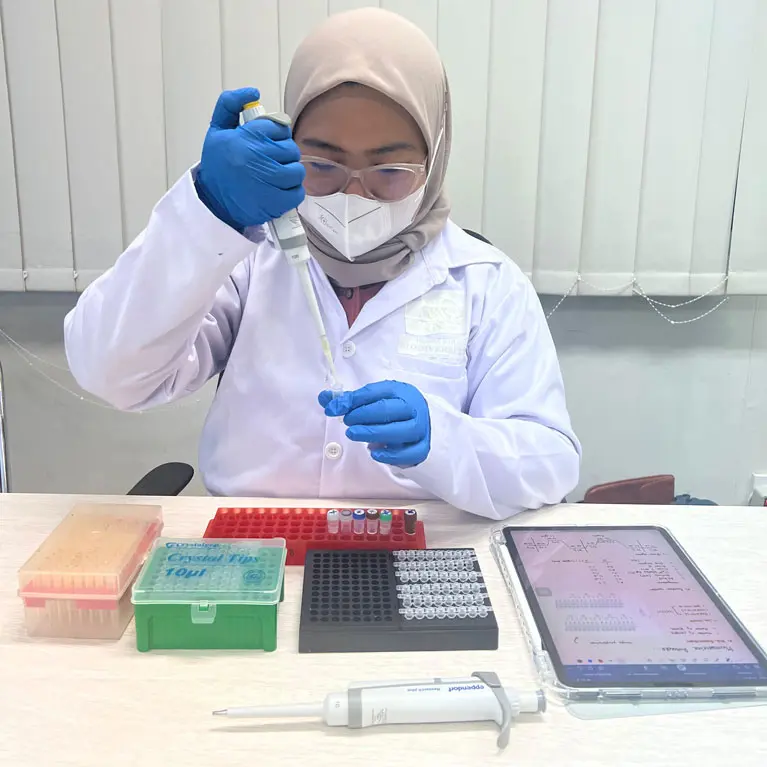Preventing genetic bottlenecks for bottlenose wedgefish
For Critically Endangered species like pari kekeh (as the bottlenose wedgefish is known in Indonesia), maintaining genetic diversity is key to their future ability to adapt to change. But when nothing is known about the reproductive strategies of a species, little can be done to tailor fisheries management to suit their particular biology and ensure a healthy gene pool. Ni is changing this; she’s studying paternity patterns within the Karimunjawa National Park. Knowing whether these wedgefish are monogamous or polygamous is essential for effective population management, where maintaining genetic diversity is key to avoiding genetic bottlenecks.
I grew up in Bali, Indonesia, an island renowned for its natural beauty, vibrant seas and rich culture. Nature was always a significant part of my childhood, but my passion for research began during my undergraduate studies at the Faculty of Biology, Universitas Gadjah Mada, Yogyakarta. My initial interest was in sea turtle conservation, a pressing issue in Bali. This experience deepened my understanding of conservation and inspired me to focus on research-driven approaches to it. My research has primarily involved molecular techniques, such as population genetics studies on sea turtles, tuna and mobula rays. I have also...
Understanding reproduction strategy of critically endangered bottlenose wedgefish in Indonesia for future species-specific conservation planning
This project will detect the reproductive strategy of the bottlenose wedgefish to enhance future species-specific management efforts in North Java, Indonesia.
We aim to provide crucial information about the mating system of the Critically Endangered bottlenose wedgefish. The project will offer valuable insights into whether the species is monogamous or polygamous, which will help ensure that efforts to conserve it are effectively tailored to its specific needs, particularly in view of Karimunjawa National Park and adjacent waters potentially being accorded Important Shark and Ray Area status.
The bottlenose wedgefish Rhynchobatus australiae, known as pari kekeh in Indonesia, is classified as Critically Endangered by the IUCN, and to address its conservation needs Indonesia has implemented regulatory measures under Ministry Law No. 1/2024. This legislation makes use of a quota system to restrict the number of bottlenose wedgefish that may be caught per year and mandates that any fish caught must be a minimum size of 1.7 metres (5.6 feet) or 23 kilograms (51 pounds). These regulations aim to help avoid a further decline in bottlenose wedgefish numbers and ensure the species’ survival in Indonesian waters. Research on this wedgefish has already been conducted here, focusing on DNA barcoding and genetic diversity, morphometrics, population growth and distribution. However, the biological aspect of research in Indonesia, especially attempts to identify reproductive strategy, is still limited. A study of the mating system (for example, are bottlenose wedgefish monogamous or polygamous?) is crucial to effective management, as understanding this dynamic will help to ensure that conservation efforts are appropriately tailored to the species’ specific needs.
One location in Indonesia that is well known for its bottlenose wedgefish habitat and population, and even as a fishing area for the species, is the Karimunjawa National Park and adjacent waters. This location is also known as an Area of Interest for an Important Shark and Ray Area (ISRA) specifically for this species. However, study of it here is still limited to its distribution, and landed catches have been monitored by the Elasmobranch Project team. Research needs to be expanded to include the species’ biology, specifically its mating system, to determine whether its population is genetically diverse or in a bottleneck situation. This project will use a genetic tool to find out about the bottlenose wedgefish’s reproductive strategy.
- To use microsatellite DNA analysis to determine paternity patterns within the bottlenose wedgefish population in the Karimunjawa National Park and adjacent waters.
- To evaluate the reproductive strategy of bottlenose wedgefish in order to improve future species-specific management efforts.
- To promote the resilience of this bottlenose wedgefish population by maintaining genetic diversity and avoiding a genetic bottleneck.


